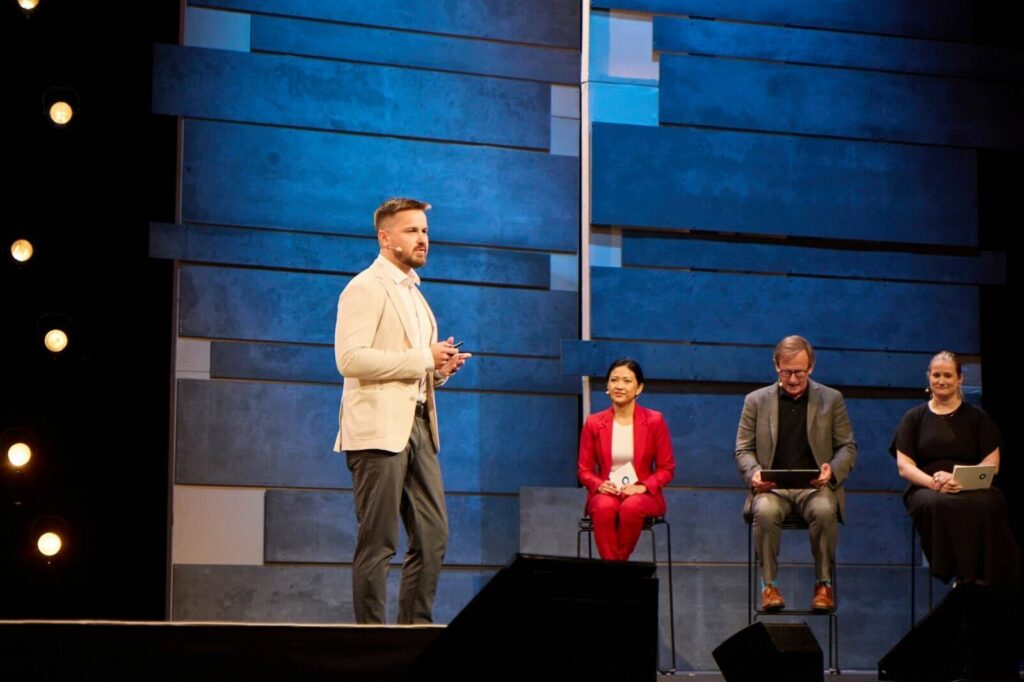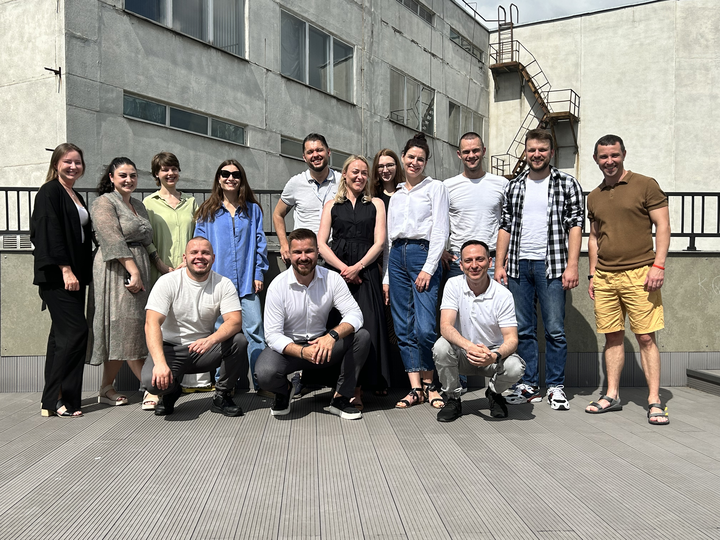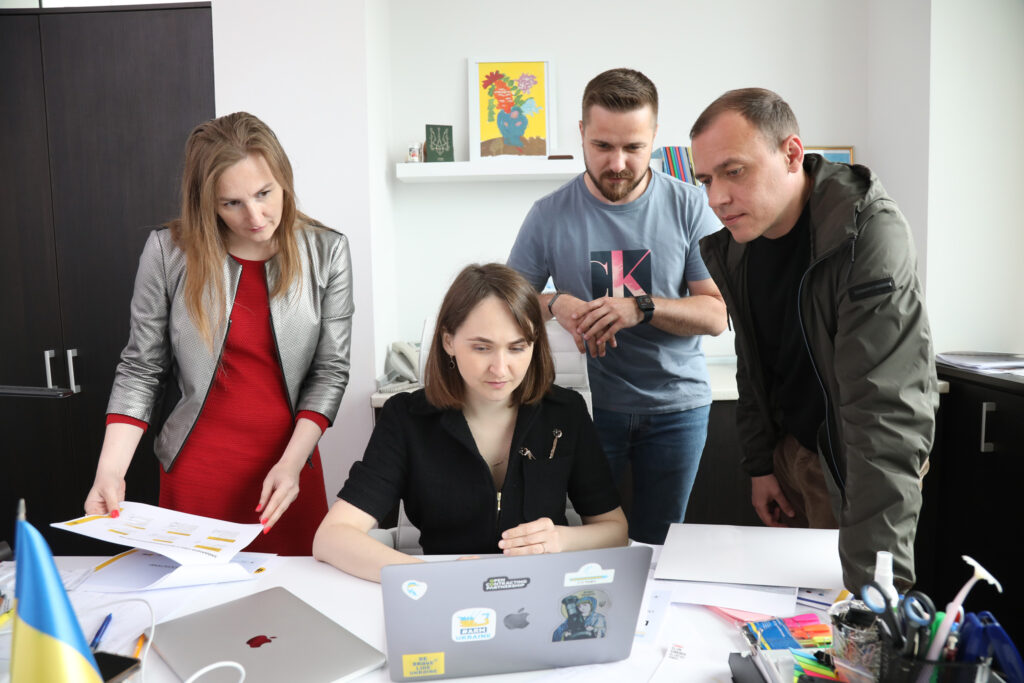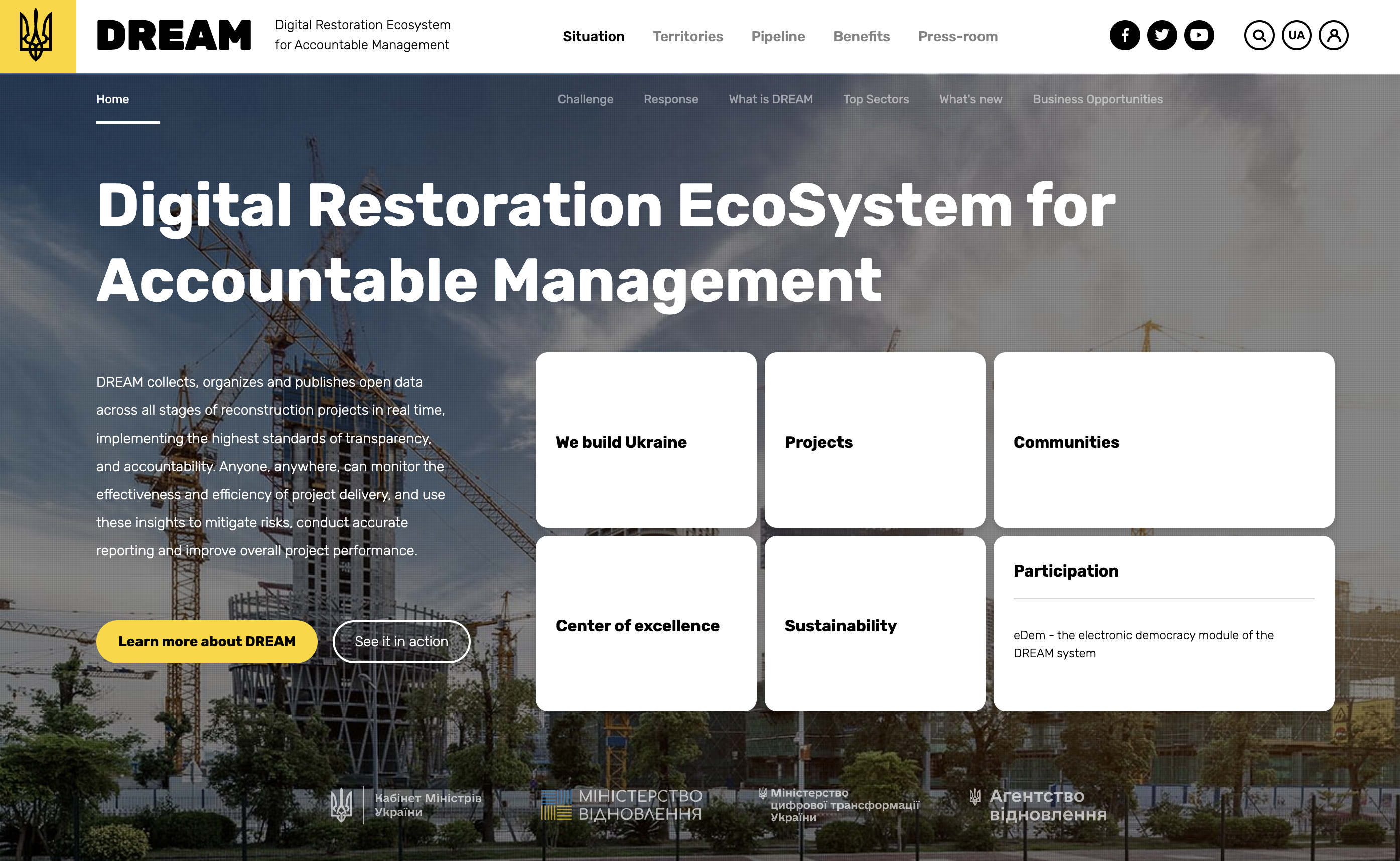The Ukrainian DREAM: Making wartime reconstruction digital and accountable

London’s Ukraine Recovery Conference saw combined international pledges of $60 billion to support the country’s transformation and reform program. In a powerful act of defiance, Ukrainians are already working to “build back better” from Russia’s appalling war of aggression.
The scale of the coordination needed will be huge. A recent assessment calculates the physical damage from the first year of the war at over $135 billion. The cost of reconstruction and recovery will be much more: at least $411 billion, 2.6 times the country’s estimated GDP in 2022.
With thousands of restoration projects to be launched already this year and tens of thousands after Ukraine’s victory, the only way to properly manage them is by using the digital tools and systems. No “brick” institution with a “paper” bureaucracy would be able to handle such a scope.
Fortunately, Ukraine has a world-beating open government and open data infrastructure that can be leveraged to help address that challenge: we articulated a vision for how this can be done late last year. Things have taken a major step forward since then. Working with the Ukrainian government, especially the Ministry and Agency for Restoration as well as our friends in the RISE Ukraine Coalition, we were delighted to unveil the demo version of a Digital Reconstruction Ecosystem for Accountable Management (DREAM) in June, to lead on making the reconstruction digitally coordinated and accountable.
The vision is to go beyond supporting “just” a transparency and reporting portal to have a digital ecosystem that integrates real-time damage assessments, budgets, project planning, procurement and delivery. DREAM creates a single pipeline from communities to funders and helps to coordinate all stages of reconstruction project implementation.
Under the Ministry of Communities, Territories and Infrastructure Development of Ukraine (Ministry for Restoration) and in collaboration with the State Agency for Restoration, OCP is now running the project office to deliver the next stages and functionalities of DREAM, thanks to the generous support of both the UK’s Foreign, Commonwealth and Development Office (FCDO) and the BHP Foundation.
The same “everyone can see everything” principle that underpins Ukraine’s award-winning Prozorro procurement system will be embedded in DREAM, which will act as the “umbrella” system to coordinate across Prozorro, the State Electronic Construction System, the Diia “government on your smartphone” app, and the State Treasury System, amongst others.
DREAM was launched at the Ukraine Recovery Conference in London. As of July, the first 1500 government users and more than 5000 projects and project ideas are already in the system, covering 24 regional restoration services and more than 500 municipalities. The system will be scaled during 2024.

DREAM development: the power of civic collaboration
The idea of DREAM was conceived within the first months of the war, when civil society organizations started thinking about the country’s reconstruction and how to put Ukraine’s open government and open data ecosystem to work. As OCP’s Head of Ukraine Support and DREAM Project Office Lead Viktor Nestulia says, “we really wanted to build a compelling example of smarter, more open government to inspire people as much in the reconstruction as our brave soldiers and citizens have done during the war.”
“We really wanted to build a compelling example of smarter, more open government to inspire people as much in the reconstruction as our brave soldiers and citizens have done during the war.”
This led to the formation of the RISE Ukraine Coalition, which at its inception united more than 20 Ukrainian organizations working on open government and anti-corruption reform. By July 2022, they had unveiled 10 principles for Ukraine’s reconstruction and modernization at the first Ukraine Reconstruction Conference in Lugano, Switzerland. Now, more than 50 national and international organizations are part of the coalition. This initial phase was supported by the BHP Foundation.
While soldiers were fighting back the Russian aggressors, the RISE Ukraine Coalition went to work, developing the case internally and externally. In less than a year, what is now DREAM went from concept to MVP.
As Deputy Minister of Community Development, Territories and Infrastructure, Oleksandra Azarkhina explains: “We followed the experience of implementing successful government digital solutions, such as Prozorro and Prozorro.Sale, when representatives of civil society, with the support of international partners, were engaged in the development of electronic systems in cooperation with government bodies. After the launch, the systems were transferred to the balance of the state in the form of a state-owned enterprise. At the same time, the state does not spend a single penny of budget funds on the creation of the system.”
Delivering the DREAM
With the launch of the Project Office, DREAM enters its next phase. Since March 2023, the ecosystem has been operating in pilot mode in English and Ukrainian. During this time, as mentioned, representatives of communities, regions, and central authorities have already submitted more than 5,000 projects and project ideas.



Each DREAM project has its own ID and project card that follows it across its lifecycle and allows any user to see what stage it has reached. To give an example: a community in the Kharkiv region wants to build a new school to replace the one destroyed by Russian shelling. Community authorities upload the information about the ruined school into the Register of Damaged and Destroyed Property (a part of the DREAM ecosystem) and create a new project based on the registry to validate that the project corresponds with a specific need.
Details must be entered for every project; in this example, the population of the future school, the facilities needed, and other characteristics. Community authorities also develop the project documentation, including cost estimates. The project is made public as part of the general project listing, so every financial organization, investment fund, or private investor can select the project to support it.
The Ministry for Restoration, jointly with the World Bank, is developing a unified methodology to prioritize projects. It includes indicators such as the population of the community affected, level of urgency, economic influence, or ecological impact.
Once the project is selected for funding, it can be tracked through the full implementation pipeline: developing procurement needs, tendering, choosing suppliers, construction, and auditing. Investors have access to all the data about the selected project at every stage of its implementation – just like any other user of the DREAM.
Donors, authorities and other users can then select say 10, 100, or 1,000 projects and use a personal dashboard to provide an overview to monitor their status simultaneously. Smart risk indicators and analytics will help users detect delays or potential issues during the implementation. Say, a set of community projects have stalled, it may be that that community is not getting enough help to be matched to a donor or enough technical support to get planning approved. The indicators will be able to flag any issue from these capacity challenges, inadequate documentation, or potential fraud and corruption.
To integrate the system, our Project Office will develop and implement the full functionality of the DREAM ecosystem, incorporate registers and systems, fill project and community pages and create analytical tools.
In a press release announcing the Project Office, Oleksandr Kubrakov, Deputy Prime Minister for Reconstruction of Ukraine and Minister of Community Development, Territories and Infrastructure of Ukraine said: “The creation of the Project Office will increase the state’s capacity to develop digital recovery tools. The experts will strengthen the team of the Ministry of Reconstruction and speed up the full launch of the ecosystem.”
The full functionality of the DREAM ecosystem is expected to go live in March 2024 and of course, that is just the start of the reconstruction coordination process. We estimate the Project Office will need $2 million a year in support in 2024 and 2025 and then around $1 million a year after that. While this is an ambitious plan, the need is compelling. This is not only a transparency portal, it’s a coordination portal, changing the power dynamics of how reconstruction is done.
Our Project Office’s other role is to engage key users and stakeholders in engaging with the ecosystem and build capacities of communities and municipalities. This is working: in June, 900 people joined a Zoom call for communities interested in pitching projects.
Projects in Ukraine’s DREAM ecosystemA long-term plan for building sustainably: changing policy and practice
As well as the DREAM ecosystem, we are also working with allies and an Inter-Ministerial Working Group to support policy and practice changes across the Ukrainian government.
The Ministry for Restoration has already passed a resolution establishing DREAM as a pilot project to coordinate the reconstruction. The resolution sees the Government publicly commit to ensure maximum transparency of the reconstruction, including the “everyone sees everything” principle, embedding open contracting practices at every stage of the process.
A second wider regulation on DREAM implementation is now in the works, which will make it the default tool to coordinate the reconstruction planning and delivery. This has been drafted and introduced into the Parliament.
Another key item is to strengthen the Prozorro e-procurement system to meet the technical requirement for international donors to use it as the default platform for their own procurements. The World Bank has provided detailed recommendations to that end that the team at Prozorro are now implementing.
A core aim for the whole project is making sure DREAM becomes the default platform for reconstruction management. The Ukrainian government is doing its bit, but will the donors, especially the IFIs like World Bank, European Investment Bank and the EBRD also be supportive? While the initial concept was greeted with skepticism, it seems that confidence in DREAM has increased significantly since the reveal at the Ukraine Reconstruction Forum.
Projects financed by the European Investment Bank, World Bank, and USAID are already uploaded to DREAM. Creating the project in DREAM is obligatory for all the local authorities looking for financing from the State Fund for Liquidation of the Consequences of Russian Aggression. As of 1 August, 159 regional and local projects received UAH 6.6 billion (EUR 165 million) from this Fund and another 139 projects are in the pipeline for approval.
DREAM is a uniquely Ukrainian, digital-first, open and collaborative answer to an incredibly challenging situation. As our Viktor Nestulia said at the URC: “We will have to rebuild thousands of destroyed homes, schools, hospitals, kindergartens, and lives. Through DREAM, Ukraine can deliver projects where they are needed, so they are sustainable, on time and budget, providing full transparency and regular reports on the reconstruction progress.”
Thanks to amazing leadership from both the Ukrainian government and civil society, we’ve seen huge progress implementing the project. We are going all in with our support to help bring it to the next level.